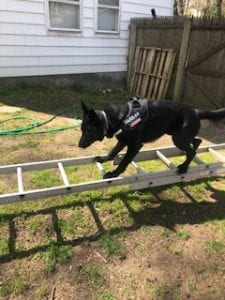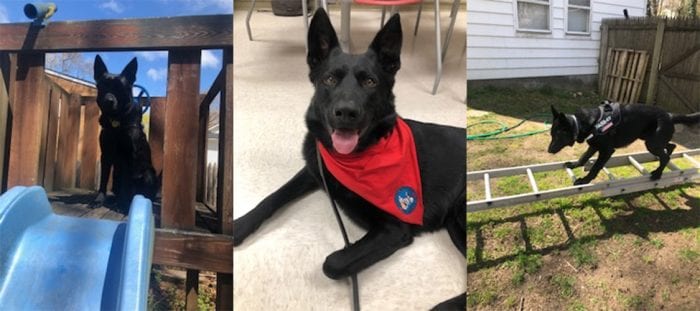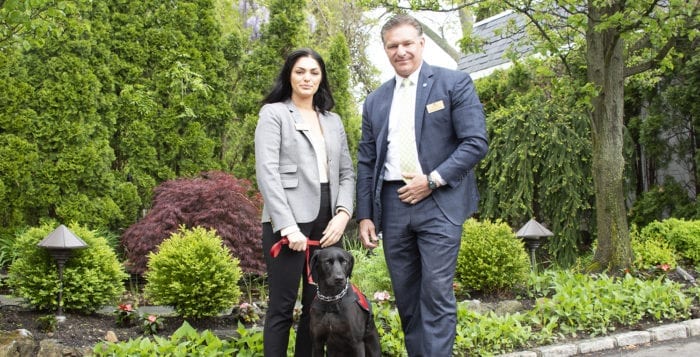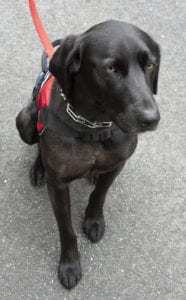By Andrew Harris
Ramsey and I look forward to our Tuesday evening visits at Stony Brook University Hospital. We visit the Child Psychiatry Unit and try our best to bring smiles to the young children who may be going through difficult times. We are part of their Volunteer Pet Therapy program and Ramsey is a trained therapy dog certified through Therapy Dogs International.

“Pet Facilitated Therapy has been a practice at SBUH hospital for many years and has brought joy and peace to staff and patients during stressful times,” said Rosemaria York, the recreational therapy supervisor at Stony Brook University Hospital.
Ramsey knows when Tuesday comes around and looks forward to visiting. He gets so excited once he sees we are on the campus, and he absolutely adores interacting with the children who love him. Ramsey is used to working — especially with children. He can be seen at the Comsewogue school district often comforting and giving lots of love during stressful times like Regents exams and other high anxiety situations.
The first time that we could not visit the hospital due to the Coronavirus situation, Ramsey was in a sullen mood. I took him for a long walk in the woods instead, but it wasn’t the same. He missed going to the hospital and the adoration from the children and staff members. We always get stopped on our way to the unit by staff members, patients, and family members who want to interact with the dog. Once, we had a special request to go visit a staff member’s friend in the cancer unit. I was amazed by how much joy it brought to her and how great he was nuzzling up to the bed and cuddling with her. What I also saw was how so many staff members came by to say hello. One doctor told us that it was a particularly hard day in that unit so she needed some cuddles too, which Ramsey gladly provided.
“Recently, the Stony Brook Medicine Department of Volunteer Services in conjunction with the Recreation Therapy Department worked together with pet therapy volunteer Andy Harris and therapy dog Ramsey to bring Virtual Pet Therapy to de-stress staff on the units,” said York.
The next thing I knew we got a phone call from the folks at Stony Brook asking if we could possibly do a virtual pet therapy visit — this time for all the nurses, doctors and medical staff at the hospital. I wasn’t sure how it would go, but we were certainly willing to give it our best try to contribute to those fine people on the front line. York told us, “Volunteer Services and Recreation therapy staff thought why not try Virtual Pet Therapy if we couldn’t have the usual visits? Stony Brook Hospital felt that because their employees were all working so hard and long, and in such a stressful situation, that perhaps a virtual visit might help in the same way that our actual visits benefitted the kids and staff.

“Due to the coronavirus pandemic when the hospital was unable to continue business as usual many practices became virtual, telehealth, etc,” York added. “So volunteer Services and recreation therapy staff thought why not virtual pet therapy if we couldn’t have the usual visits?”
I knew it would be much different then our normal in-person visits and had to come up with some new ideas because we would be doing our thing from the backyard of our house. Simultaneously, the folks at Stony Brook would be working extra hard walking all over the hospital from unit to unit donned in full PPE gear.
Normally with the kids, we sit down, chat or read a book and just let the kids cuddle with the dog. We demonstrate how Ramsey has learned not to take food from people or off the floor unless he is given permission. We show how he sits, waits patiently and knows all the different commands. As a therapy dog he has learned not to “shake hands” because this and jumping up on them could compromise people with vulnerable skin conditions. He is not allowed to eat any food because this could be a problem too if there are crumbs in the bed or on someone’s gown in a hospital or nursing home setting.
Sometimes the kids like to see the dog “work” and do some finds. They hide some articles of clothing like a glove or hat somewhere in the room as the dog patiently waits outside the room. As soon as he enters he sniffs it out and finds all the articles. Of course he always gets a reward each time he does a good job.
Since my yard is set up with plenty of things to do with the dog, we were ready to not only provide some therapy for the workers, but to entertain and show them what the dog could do. York said, “… so some recreation therapists armed with an iPad with Mr. Harris and Ramsey streaming live brought Ramsey and his athletic agility abilities along with a bark and a close up camera ‘social distanced’ kiss to the staff.”

First I had him doing the normal stuff, retrieve a ball and relayed the typical commands most people are familiar with. As I pointed the camera on my phone at him, I could hear some nurses getting a kick out of it all — so we decided to step it up a bit. The “ooo’s” and “ahhs” were noticeable especially when he climbed up the ladder to our playhouse and went down the slide. He then showed how he could run up the slide. His final performance, and the most difficult, was walking across a twenty foot ladder propped horizontally raised a few feet off the ground. For that he got a round of applause. When we went back inside he was very exhausted, lay down and took a long nap. We were happy to put a little smile to the wonderful staff at Stony Brook.
York said, “staff stated that they were happy for the opportunity to interact with the therapy dog even if it was brief and virtual as it brought a smile to their day.”
Andrew Harris is a special needs teacher at the Comsewogue school district.







